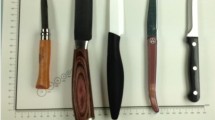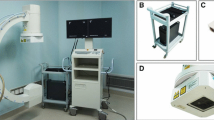Abstract
Background/Aims
Needle-stick injuries provide a substantial threat in regard to health of victims and may cause extra costs to health systems.
Materials and methods
We report on simple strategies to prevent a needle-stick injury by analysing search devices which can detect a lost needle.
Results
A magnetic device enables the surgeon as well as other staff members working in the operating room to locate a lost needle on the floor rapidly. For search in body cavities, X-ray examination is recommended.
Conclusion
With simple methods, a lost needle can be found easily to prevent any harm for others in the future.



Similar content being viewed by others
References
Wicker S, Gottschalk R, Rabenau HF (2007) Gefährdung durch Nadelstichverletzungen. Dtsch Arztbl 104:A3102–A3107
Henry K, Campbell S (1995) Needlestick/sharp injuries and HIV exposure among health care workers. Minn Med 78:41–44
Trim JC, Elliot TS (2003) A review of sharps injuries and preventative strategies. J Hosp Infect 53:237–242
Raghavendran S, Bagry HS, Leith S, Budd JM (2006) Needle stick injuries: a comparison of practice and attitudes in two UK District General Hospitals. Anaesthesia 61:867–872
Makary MA, Al-Attar A, Holzmueller CG et al (2007) Needlestick injuries among surgeons in training. N Engl J Med 356:2693–2699
Health Protection Agency Centre for Infections, National Health Service of Wales, CDSC Northern Ireland (2005) Eye of the needle. Health Protection Agency, London
Comptroller and Auditor General (2003) A safer place to work—improving the management of health, safety risks to staff in NHS trusts. London, UK
Expert Advisory Group on AIDS and the Advisory Group on Hepatitis (1998) Guidance for clinical health care workers: protection against infection with bloodborne viruses. UK Health Departments, London
Prüss-Üstün A, Rapiti E, Hutin Y (2005) Estimation of the global burden of disease attributable to contaminated sharps injuries among health-care workers. Am J Ind Med 48:482–490
Ramsay ME (1999) Guidance on the investigation and management of occupational exposure to hepatitis C. Commun Dis Public Health 2:258–262
Cardo D, Culver DH, Ciesielski CA et al (1997) A case control study of HIV sero-conversion in health care workers after percutaneous exposure. N Engl J Med 337:1485–1490
Center for Disease Control (2001) Updated U.S. Public Health Service Guidelines for the Management of Occupational Exposures to HBV, HCV, and HIV and Recommendations for Postexposure Prophylaxis
UK Chief Medical Officers’ Expert Advisory Group on AIDS (2004) HIV post-exposure prophylaxis. Department of Health, London
Louie T (2005) Occupational hazards. N Engl J Med 353:757–759
Sohn J-W, Kim B-G, Kim S-H, Han C (2006) Mental health of healthcare workers who experience needlestick and sharp injuries. J Occup Health 48:474–479
Macilquham MD, Riley RG, Grossberg P (2003) Identifying lost surgical needles using radiographic techniques. AORN J 78:73–78
Hirsch M, Gueron M, Moses S, Merin G (1975) Delayed hemopericardium following penetrating foreign body into the aorta. Pediat Radiol 3:111–113
Acknowledgements
The authors wish to thank chief nurse Karin Brandt-Laurencic of the operating room staff (Technical University of Munich, Germany) for her sophisticated input in finding the most appropriate tool for needle search. The authors appreciate the skillful work of the photographer, Mr Andreas Mauermayer.
Author information
Authors and Affiliations
Corresponding author
Rights and permissions
About this article
Cite this article
Möhrenschlager, M., Ring, J., Henkel, V. et al. Lost needle: a simple search device for the operating room’s floor. Langenbecks Arch Surg 393, 1009–1011 (2008). https://doi.org/10.1007/s00423-007-0252-8
Received:
Accepted:
Published:
Issue Date:
DOI: https://doi.org/10.1007/s00423-007-0252-8




